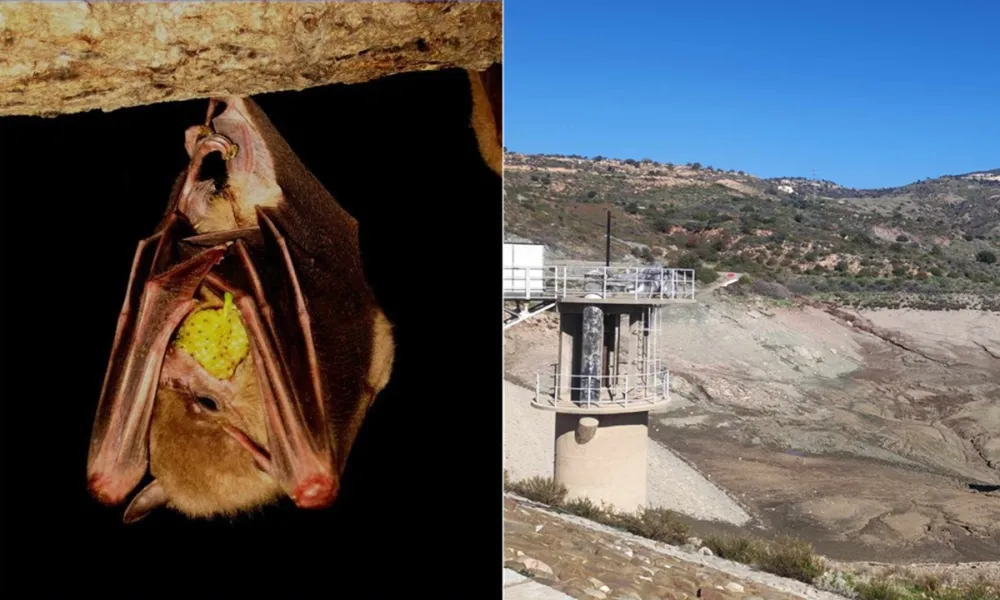By Kiki Perikleous
Bats are not out of hell, we’re not going batty and the species are obviously not insidious spies of demons. The forestry department, seeking to educate the public about the benefits of the bat to societies, notes that urban legends and mediaeval beliefs rooted in religion of fear, have helped forge a bad name for the nocturnals. When in fact, they are supremely helpful in ridding the countryside from harmful pests.
19 species of bats have been recorded across Cyprus so far, according to Charis Nikolaou, a biodiversity specialist at the forestry department. He notes that every single one of these species has come to the island in a natural manner, while the rest of the mammals endemic to the country, have been artificially introduced by humans.
18 of the species belong to the family of Chiroptera and are insect eaters, while one is a Megachiropteron, known in the local vernacular as nyktopapparos (the one who doesn’t sleep at night), living on fruit and considered the largest bat in Cyprus.
Description
As Nicolaou says, most of the bat species resemble mice, while the largest of them, look more like foxes. Flying but not egg laying, bats have babies and they even breastfeed. Their skin is covered by four in instead of wings, they have elongated leather membranes, helping them to fly and keep balance in he air. Their vision is good but their most developed sense is hearing. Their night orientation rises above every other nocturnal organism, as they also emit ultrasounds in various directions and at various objects (beyond human ability), with the reverberation helping them orientate in the dark, locate their prey, avoid any obstacles and return safely to their place of sleep.
As Charis Nikolaou tells ‘Politis’, bats inhabit almost all types of ecosystems, except the polar extremes and deserts, not able to survive such conditions. They prevent mixed vegetation, broad leaved forests, where one can find trees with large hollows, as well as areas near water sources, such as rivers, lakes and swamps, but also prairis and farmlands, not excluding urban areas. They nest in caves, tree hollows and old dilapidated abandoned buildings. They move around, not necessarily using the same shelter through the year, while a number of these species can be migratory.
They rest during the day, a strong grip helping them sleep hanging head down. Most people’s impression that they feed with the blood of other animals, is simply wrong, as only three out of the 1200 species recorded around the world drain and consume the blood of birds or mammals. Bats are a quarter of all living mammals and the only one of their species that can fly.
Protective measures
Humans are the greatest enemy of bats, one of the most endangered mammals globally. Competent authorities internationally are taking drastic action to protect bats in the framework of European funded programmes, but also at national level as part of biodiversity projects. As Charis Nikolaou notes, one of the main ways of protecting them is to maintain their ecosystems, but mostly their nesting sites. Caves should not be sealed, perhaps just railings added, so bats could access the area easily. Old, hollowed trees should be preserved and artificial shelters (special wooden boxes) created around four metres from the ground. The use of agricultural pesticides should be monitored, while warehouses, houses and other buildings used by bats must be preserved , with access open to bats. Lack of control in building photovoltaic parks also restrict feeding sites for these species.
The fruit eating bats have been hunted down over the last 100 years, as they were considered harmful to cultivations, with its population further restricted by the loss of habitat. It grows somewhat seasonally, but numbers on the whole, have declined severely.
Bats were poisoned in caves and shot down, most of the time by the state itself. Such campaigns were terminated officially in 1983. The poisoning of the bats inside their caves led to the destruction of the whole ecosystem.
Nikolaou makes clear that the species have been grossly misunderstood and persecuted by humans, as they became connected to bad omens and superstition, maintained by ignorance and fear. In reality, they are greatly beneficial and need to be protected, as they rid both cultivations and forests from harmful insects, on which they feed on, but also by consuming overripe fruit. This prevents the use of pesticides, destroying ecosystems. Many use bat faeces as fertilisers, is they are made up of insect remains, essentially a source of protein.
‘They have a significant role to play in our survival’, Nikolaou concluded.
